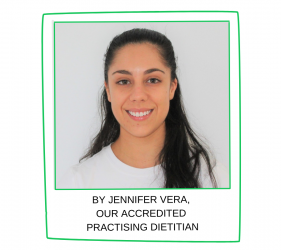
PART 1 – The Diet plan
The Low FODMAP Diet
FODMAP stands for Fermentable Oligosaccharides, Disaccharides, Monosaccharides, and Polyols, which are the groups of carbohydrates sugars that are not completely absorbed, or digested in the small intestine. This may lead to bloating, constipation, pain, gas, diarrhea, or a mix of each. Did you know that a low FODMAP diet is most commonly used to treat and alleviate symptoms of Irritable Bowel Syndrome (IBS)? It may also benefit other bowel-related issues such as Inflammatory Bowel Disease, malabsorption, bacterial overgrowth, and many more!
FODMAPs and Digestion (or in-digestion)
Let’s take a look at what happens when an individual consumes high FODMAP foods:
- Foods are broken down into smaller sugars, but not completely digested.
- Once reaching the small intestine, water is drawn into the bowel and ferments in the large intestine.
- The excess gas and fluid triggers IBS-like symptoms (eg abdominal pain, bloating, constipation or diarrhea, vomiting, or a combination of both)
Tolerance levels of the various FODMAPs is not a “one-size fits all” approach. Some individuals may tolerate small amounts, while others experience discomfort even from a tiny bite. It should also be noted that some FODMAP groups may be well tolerated, while only specific ones are not, therefore leading to sensitivity or malabsorption of one group, rather than several.

The FODMAP Food Groups & Common Sugars
Groups | Common Sugars | Examples of High FODMAP Foods |
Oligosaccharides | Fructans & Galacto-oligosaccharides (GOS) | Wheat, rye, onions, garlic, cashews, almonds, tofu legumes/lentils |
Disaccharides | Lactose Note: The amount of lactose present may depend on the type of dairy product and how it’s fermented. | Dairy products i.e. Milk, yogurt, soft cheese, cream cheese, ice cream, custard |
Monosaccharides | Fructose | Honey, dried fruits, grapes, apples, banana, mango, baked beans, broad beans |
Polyols | Mannitol, Sorbitol, Xylitol | Mainly in fruits and vegetables i.e. Watermelon, apricot, blackberries, cauliflower, corn, mushroom, sweet potato, coconut and artificial sweeteners |
Purpose of a Low FODMAP Diet Plan
This diet is designed to relieve IBS symptoms and determine problematic food triggers causing pain, discomfort or disruption. It is a short-term elimination diet, where all FODMAP groups are removed for 4-6 weeks or until symptoms have settled. Each FODMAP group is then re-introduced through a challenge phase to determine which, if any, are the triggers.
We strongly advise individuals to conduct this diet under a dietitian, GP or a healthcare professional/specialist in the field, to ensure an individual-level of appropriateness and avoid nutritional deficiencies or health risks.
Although this diet may be suited for people struggling with IBS, other contributing factors must be considered such as stress/anxiety, medications, lactose intolerance, alcohol, spices, and caffeine, as these are common gut irritants.
People who may benefit from this diet include:
- People diagnosed with IBS (~75% respond well)
- People with IBD (Inflammatory Bowel Disease) who still experience symptoms
- Coeliac disease with ongoing symptoms despite being on a gluten-free diet
- Non-coeliac gluten sensitivity
- Endometriosis

Keep an eye out for Part 2 of this series, where Jennifer will provide tips for dining out on a low FODMAP diet. And browse through our partner venues, to see which delicious menu items match your dietary profile.

